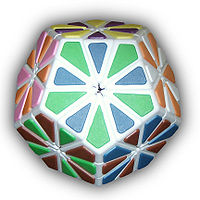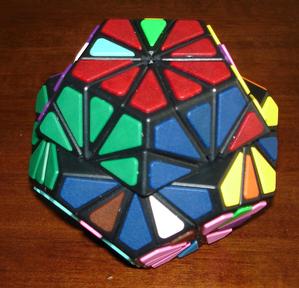
Pyraminx Crystal
Encyclopedia

Rubik's Cube
Rubik's Cube is a 3-D mechanical puzzle invented in 1974 by Hungarian sculptor and professor of architecture Ernő Rubik.Originally called the "Magic Cube", the puzzle was licensed by Rubik to be sold by Ideal Toy Corp. in 1980 and won the German Game of the Year special award for Best Puzzle that...
and the Megaminx
Megaminx
The Megaminx is a dodecahedron-shaped puzzle similar to the Rubik's Cube. It has a total of 50 movable pieces to rearrange, compared to the 20 movable pieces of the Rubik's cube.- History :...
. It is manufactured and sold by Uwe Mèffert
Uwe Mèffert
Uwe Mèffert has manufactured and sold mechanical puzzles in the style of Rubik's Cube since the original Cube craze. His first design was the Pyraminx and others include the Megaminx, Skewb and Skewb Diamond...
in his puzzle shop since 2008.
It is not to be confused with the Pyraminx
Pyraminx
The Pyraminx is a tetrahedral puzzle similar to the Rubik's Cube. It was invented and patented by Uwe Meffert, and introduced by Tomy Toys of Japan in 1981. Meffert continues to sell it in his toy shop, ....
, which is also invented and sold by Meffert.
History

In late 2007, due to requests by puzzle fans worldwide, Uwe Mèffert began manufacturing the puzzle. The puzzles were first shipped in February 2008. There are two 12-color versions, one with the black body commonly used for the Rubik's Cube and its variations, and one with a white body.
A company named QJ made an illegal copy of this puzzle in 2010 and Meffert's puzzles files a lawsuit against this company, which is currently on its way.
The Pyraminx Crystal ran out of stock fairly quickly, and became a collector's puzzle. In October of 2011, a new set was created with some slight improvements to the quality.
Description

Pentagon
In geometry, a pentagon is any five-sided polygon. A pentagon may be simple or self-intersecting. The sum of the internal angles in a simple pentagon is 540°. A pentagram is an example of a self-intersecting pentagon.- Regular pentagons :In a regular pentagon, all sides are equal in length and...
al face. This cuts the puzzle into 20 corner pieces and 30 edge pieces, with 50 pieces in total.
Each face consists of five corners and five edges. When a face is turned, these pieces and five additional edges move with it. Each corner is shared by 3 faces, and each edge is shared by 2 faces. By alternately rotating adjacent faces, the pieces may be permuted.
The goal of the puzzle is the scramble the colors, and then return it to its original state.
Solutions
The puzzle is essentially a deeper-cut version of the MegaminxMegaminx
The Megaminx is a dodecahedron-shaped puzzle similar to the Rubik's Cube. It has a total of 50 movable pieces to rearrange, compared to the 20 movable pieces of the Rubik's cube.- History :...
, and the same algorithms used for solving the Megaminx's corners may be used to solve the corners on the Pyraminx Crystal. The edge pieces can then be permuted by a simple 4-twist algorithm, R L' R' L, that leaves the corners untouched, in a manner similar to the Pyraminx
Pyraminx
The Pyraminx is a tetrahedral puzzle similar to the Rubik's Cube. It was invented and patented by Uwe Meffert, and introduced by Tomy Toys of Japan in 1981. Meffert continues to sell it in his toy shop, ....
. This can be applied repeatedly until the edges are solved.
Number of combinations
There are 30 edge pieces with 2 orientations each, and 20 corner pieces with 3 orientations each, giving a maximum of 30!·230·20!·320 possible combinations. However, this limit is not reached because:- Only even permutations of edges are possible, reducing the possible edge arrangements to 30!/2.
- The orientation of the last edge is determined by the orientation of the other edges, reducing the number of edge orientations to 229.
- Only even permutations of corners are possible, reducing the possible corner arrangements to 20!/2.
- The orientation of the last corner is determined by the orientation of the other corners, reducing the number of corner combinations to 319.
- The orientation of the puzzle does not matter (since there are no fixed face centers to serve as reference points), dividing the final total by 60. There are 60 possible positions and orientations of the first corner, but all of them are equivalent because of the lack of face centers.
This gives a total of
 possible combinations.
possible combinations.The full figure is 167 782 694 255 872 245 204 193 387 189 409 175 281 146 860 685 032 947 712 000 000 000 (roughly 1.68 unvigintillion on the short scale
Names of large numbers
This article lists and discusses the usage and derivation of names of large numbers, together with their possible extensions.The following table lists those names of large numbers which are found in many English dictionaries and thus have a special claim to being "real words"...
or 1.68 undecillion on the long scale).
See also
- Rubik's cubeRubik's CubeRubik's Cube is a 3-D mechanical puzzle invented in 1974 by Hungarian sculptor and professor of architecture Ernő Rubik.Originally called the "Magic Cube", the puzzle was licensed by Rubik to be sold by Ideal Toy Corp. in 1980 and won the German Game of the Year special award for Best Puzzle that...
- MegaminxMegaminxThe Megaminx is a dodecahedron-shaped puzzle similar to the Rubik's Cube. It has a total of 50 movable pieces to rearrange, compared to the 20 movable pieces of the Rubik's cube.- History :...
- DogicDogicThe Dogic is an icosahedron-shaped puzzle like the Rubik's cube. The 5 triangles meeting at its tips may be rotated, or 5 entire faces around the tip may be rotated. It has a total of 80 movable pieces to rearrange, compared to the 20 pieces in the Rubik's cube.- History :The Dogic was patented by...
- PyraminxPyraminxThe Pyraminx is a tetrahedral puzzle similar to the Rubik's Cube. It was invented and patented by Uwe Meffert, and introduced by Tomy Toys of Japan in 1981. Meffert continues to sell it in his toy shop, ....
- Combination puzzle
- Mechanical puzzleMechanical puzzleA mechanical puzzle is a puzzle presented as a set of mechanically interlinked pieces.- History :The oldest known mechanical puzzle comes from Greece and appeared in the 3rd century BC....

